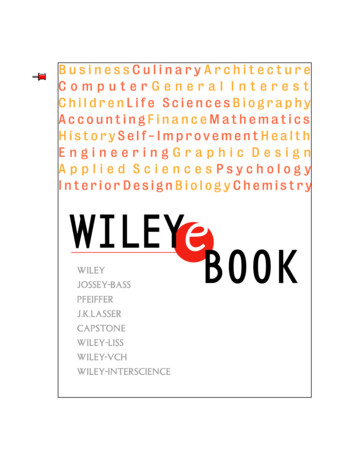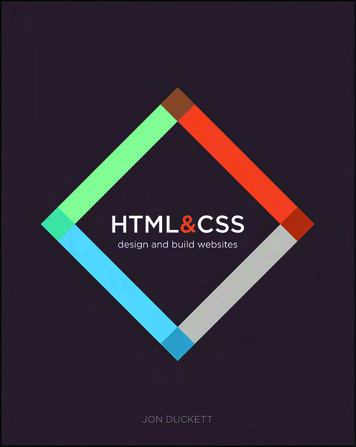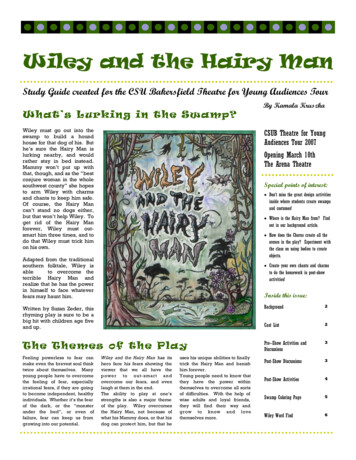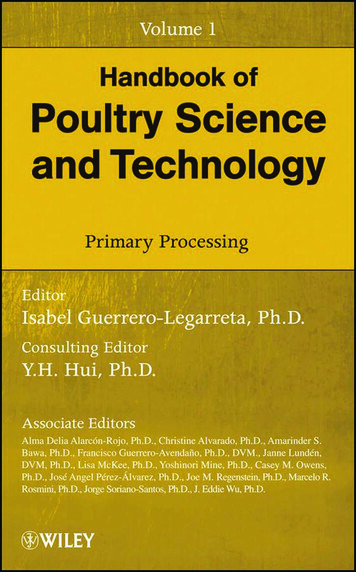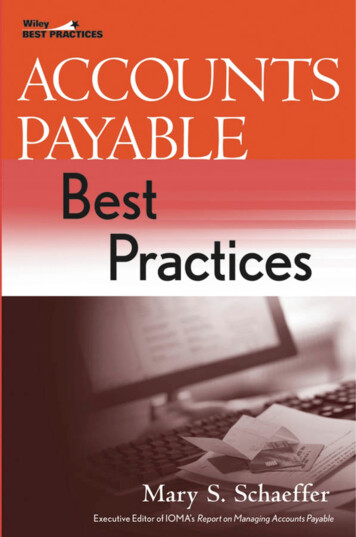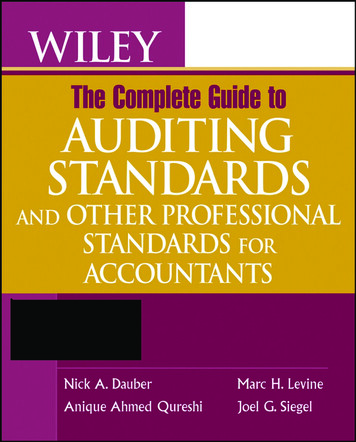
Transcription
1/2 TiTLe PAGeWileyThe Complete Guide toAuditingStandardsand OtherProfessionalStandards forAccountants2008
BECOME A SUBSCRIBER!Did you purchase this product from a bookstore?If you did, it’s important for you to become a subscriber. John Wiley & Sons, Inc.may publish, on a periodic basis, supplements and new editions to reflect the latestchanges in the subject matter that you need to know in order stay competitive inthis ever-changing industry. By contacting the Wiley office nearest you, you’ll receiveany current update at no additional charge. In addition, you’ll receive future updatesand revised or related volumes on a 30-day examination review.If you purchased this product directly from John Wiley & Sons, Inc., we have alreadyrecorded your subscription for this update service.To become a subscriber, please call 1-877-762-2974 or send your name, companyname (if applicable), address, and the title of the product to:mailing address:Supplement DepartmentJohn Wiley & Sons, Inc.One Wiley DriveSomerset, NJ 02-2300www.wiley.comFor customers outside the United States, please contact the Wiley office nearest you:Professional & Reference DivisionJohn Wiley & Sons Canada, Ltd.22 Worcester RoadEtobicoke, Ontario M9W 1L1CANADAPhone: 416- 236-4433Phone: 1-800-567-4797Fax: 416-236-4447Email: canada@jwiley.comJohn Wiley & Sons, Ltd.The AtriumSouthern Gate, ChichesterWest Sussex, PO19 8SQENGLANDPhone: 44-1243 779777Fax: 44-1243 775878Email: customer@wiley.co.ukJohn Wiley & Sons Australia, Ltd.33 Park RoadP.O. Box 1226Milton, Queensland 4064AUSTRALIAPhone: 61-7-3859-9755Fax: 61-7-3859-9715Email: brisbane@johnwiley.com.auJohn Wiley & Sons (Asia) Pte. Ltd.2 Clementi Loop #02-01SINGAPORE 129809Phone: 65-64632400Fax: 65-64634604/5/6Customer Service: 65-64604280Email: enquiry@wiley.com.sg
WileyThe Complete Guide toAuditingStandardsand OtherProfessionalStandards forAccountants2008Nick A. DauberMarc H. LevineAnique Ahmed QureshiJoel G. SiegelJOHN WILEY & SONS, INC.
This book is printed on acid-free paper. ( )Copyright 2008 by John Wiley & Sons, Inc. All rights reserved.Published by John Wiley & Sons, Inc., Hoboken, New JerseyPublished simultaneously in CanadaNo part of this publication may be reproduced, stored in a retrieval system, or transmitted inany form or by any means, electronic, mechanical, photocopying, recording, scanning, orotherwise, except as permitted under Section 107 or 108 of the 1976 United States CopyrightAct, without either the prior written permission of the Publisher, or authorization throughpayment of the appropriate per-copy fee to the Copyright Clearance Center, Inc., 222Rosewood Drive, Danvers, MA 01923, 978-750-8400, fax 978-646-8600, or on the Web atwww.copyright.com. Requests to the Publisher for permission should be addressed to thePermissions Department, John Wiley & Sons, Inc., 111 River Street, Hoboken, NJ 07030,201-748-6011, fax 201-748-6008, or online at http://www.wiley.com/go/permissions.Limit of Liability/Disclaimer of Warranty: While the publisher and author have used theirbest efforts in preparing this book, they make no representations or warranties with respect tothe accuracy or completeness of the contents of this book and specifically disclaim anyimplied warranties of merchantability or fitness for a particular purpose. No warranty may becreated or extended by sales representatives or written sales materials. The advice andstrategies contained herein may not be suitable for your situation. You should consult with aprofessional where appropriate. Neither the publisher nor author shall be liable for any lossof profit or any other commercial damages, including but not limited to special, incidental,consequential, or other damages.For general information on our other products and services or technical support, pleasecontact our Customer Care Department within the United States at 800-762-2974, outside theUnited States at 317-572-3993 or fax 317-572-4002.Wiley also publishes its books in a variety of electronic formats. Some content that appearsin print may not be available in electronic books. For more information about Wileyproducts, visit our Web site at http://www.wiley.com.Library of Congress Cataloging-in-Publication Data:Wiley, the complete guide to auditing standards, and other professional standards foraccountants, 2008 / Nick A. Dauberp. cm.Includes index.ISBN 978-0-470-18397-7 (pbk.)1. Auditing – Standards – United States – Handbooks, manuals, etc. 2. Accounting– Standards – United States – Handbooks, manuals, etc. I. Dauber, Nicky A. II. JohnWiley & Sons. III. Title: Complete guide to auditing standards, and other professionalstandards for accountants. IV. Title: Guide to auditing standards, and other professionalstandards for accountants. V. Title: Auditing standards, and other professional standardsfor accountants.HF5616.U5W559 2008657.02’1873—dc222008002755Printed in the United States of America10987654321
DEDICATED TOKAREN J. DAUBERLoving wife and dear friendKATIE AND MICHAEL DAUBERPrecious childrenMARGIE, MARC AND SUSAN DAUBERLoving and wonderful mother, father, and sisterSHAHEEN QURESHILoving wifeAQSA N. QURESHI AND YASEEN A. QURESHIWonderful childrenMOHAMMAD RAFIQUE QURESHI AND ZAKIA QURESHILoving parentsCAROL LEVINEDedicated wife and friendREVA, DANIEL AND SORI LEVINELoving childrenYAAKOV LEVINELoving GrandsonTESSIE and SAMUEL LEVINEDearly departed Mother and FatherROBERTA M. SIEGELLoving wife, colleague and best friend
CONTENTSTitlePart 1 Auditing Standards of the PCAOBPageNo.1References in Auditor’s Reports to the Standards of the PublicCompany Accounting Oversight Board .33Audit Documentation.54Reporting on Whether a Previously Reported Material WeaknessContinues to Exist .7An Audit of Internal Control over Financial Reporting That IsIntegrated with an Audit of Financial Statements .1515Part 2 Auditing27110Responsibilities and Functions of the Independent Auditor .29120Defining Professional Requirements in Statements on AuditingStandards.31150Generally Accepted Auditing Standards.33161The Relationship of Generally Accepted Auditing Standards toQuality Control Standards.35201Nature of the General Standards.37210Training and Proficiency of the Independent Auditor .37220Independence .37230Due Professional Care in the Performance of Work.37310Appointment of the Independent Auditor .39311Planning and Supervision .41312Audit Risk and Materiality .53315Communications between Predecessor and Successor Auditors .63316Consideration of Fraud in a Financial Statement Audit.69317Illegal Acts by Clients .79318Performing Audit Procedures in Response to Assessed Risks andEvaluating the Audit Evidence Obtained .83319Consideration of Internal Control in a Financial Statement Audit .91322The Auditor’s Consideration of the Internal Audit Function in anAudit of Financial Statements.109324Service Organizations.115325Communication of Internal Control Related Matters Noted in anAudit .119326Evidential Matter .125328Auditing Fair Value Measurements and Disclosures.131
329Analytical Procedures.141330The Confirmation Process .145331Inventories .163332Auditing Derivative Instruments, Hedging Activities, andInvestments in Securities .171333Management Representation .179334Related Parties .187336Using the Work of a Specialist .197337Inquiry of Client’s Lawyer Concerning Litigation, Claims, andAssessments .207339Audit Documentation.211341Ability of the Entity to Continue as a Going Concern.215342Auditing Accounting Estimates .221350Audit Sampling.229380Communication with Audit Committees .233390Consideration of Omitted Procedures After the Report Date .247411The Meaning of “Present Fairly in Conformity with GenerallyAccepted Accounting Principles” .249420Consistency of Application of Generally Accepted AccountingPrinciples.253431Adequacy of Disclosure in Financial Statements .257504Association with Financial Statements .259508Reports on Audited Financial Statements.263530Dating of the Independent Auditor’s Report .277532Restricting the Use of an Auditor’s Report.279534Reporting on Financial Statements Prepared for Use in OtherCountries .281543Part of Audit Performed by Other Independent Auditors .285544Lack of Conformity with Generally Accepted Accounting Principles .289550Other Information in Documents Containing Audited FinancialStatements .291551Reporting on Information Accompanying the Basic FinancialStatements in Auditor-Submitted Documents .293552Reporting on Condensed Financial Statements and Selected FinancialData .297558Required Supplementary Information.299560Subsequent Events .303561Subsequent Discovery of Facts Existing at the Date of the Auditor’sReport.305
623Special Reports .307625Reports on the Application of Accounting Principles .319634Letters for Underwriters and Certain Other Requesting Parties .323711Filings under Federal Securities Statutes.329722Interim Financial Information.331801Compliance Auditing Considerations in Audits of GovernmentalEntities and Recipients of Governmental Financial Assistance .335Public Warehouses: Controls and Auditing Procedures for Goods Held339901Part 3 Attestation34520Defining Professional Requirements in Statements on Standards forAttestation Engagements.34750SSAE Hierarchy .349101Attestation Engagements .351201Agreed-Upon Procedures Engagements .359301Financial Forecasts and Projections.363401Reporting on Pro Forma Financial Information.375501Reporting on an Entity’s Internal Control over Financial Reporting.381601Compliance Attestation .391701Management’s Discussion and Analysis .401Part 4 Accounting and Review Services40950Standards for Accounting and Review Services .411100Compilation and Review of Financial Statements.413110Compilations of Specified Elements, Accounts, or Items of a FinancialStatement.429120Compilation of Pro Forma Financial Information .433200Reporting on Comparative Financial Statements.437300Compilation Reports on Financial Statements Included in CertainPrescribed Forms.443400Communications between Predecessor and Successor Accountants .445600Reporting on Personal Financial Statements Included in WrittenPersonal Financial Plans .447Part 5 Consulting Services100Consulting Services: Definitions and Standards.449451
Part 6 Quality Control45320System of Quality Control for a CPA Firm’s Accounting and AuditingPractice.45530Monitoring a CPA Firm’s Accounting and Auditing Practice.45940The Personnel Management Element of a Firm’s System of QualityControl—Competencies Required by a Practitioner in Charge of anAttest Engagement .461Part 7 Tax Services463Preface .465100Tax Return Positions.467200Answers to Question on Tax Returns .469300Certain Procedural Aspects of Preparing Returns.471400Use of Estimates .473500Departure from a Position Previously Concluded in an AdministrativeProceeding or Court Decision .475600Knowledge of Error: Return Preparation.477700Knowledge of Error: Administrative Proceeding .479800Form and Content of Advice to Taxpayers.481Part 8 Personal Financial Planning483Basic Personal Financial Planning Engagement Functions andResponsibilities .485200Working with Other Advisors.489300Implementation Engagement Functions and Responsibilities .491400Monitoring and Updating Engagements—Functions andResponsibilities .493Developing a Basis for Recommendations .495100500Part 9 Statement on Standards for Valuation Services497Statement 1 Valuation of a Business, Business Ownership Interest,Security, or Intangible Assets.499Appendix A: Cross-References to Statements on Auditing Standards.511Appendix B: Cross-References to Statements on Standards for AttestationEngagements .515Appendix C: Cross-References to Statements on Standards for Accountingand Review Services .517Index.519
PREFACEThe Complete Guide to Auditing Standards and Other Professional Standards for Accountants 2008 is written primarily to help auditors and certified public accountants (CPAs)apply and comply with authoritative auditing and other professional standards. It represents acomprehensive, up-to-date compendium of current auditing standards, including therequirements of the Public Company Accounting Oversight Board (PCAOB), establishedunder the Sarbanes-Oxley Act. The PCAOB now requires that the audit report state that theaudit engagement was conducted in accordance with its standards rather than, as previously,with generally accepted auditing standards (GAAS).The book emphasizes practical applications to implement audit and other professionalstandards and requirements.We coverAuditing Standards of the PCAOBStatements on Auditing Standards (SAS)Statements on Standards for Attestation Engagements (SSAE)Statements on Standards for Accounting and Review Services (SSARS)Interpretations of SAS, SSARS, and SSAEStatements on Consulting ServicesStatements on Quality ControlStatements on Standards for Tax Services (SSTS)Statements on Personal Financial PlanningStatement on Standards for Valuation ServicesThe text covers all the topics an auditor must know aboutAudit reports:General standardsFieldwork standardsStandards of reporting:Special reportsInternal controlCompliance auditingApplication of agreed-upon procedures:Letters for underwritersAttestation engagementsAccounting and review servicesFilings under federal securities statutesInterim financial informationStatistical samplingWe intend the book to be a valuable reference for not only accounting and auditing professionals but also for persons who must interact with auditors, such as company managers,bank loan officers, suppliers, current and potential investors, and workers at governmentalaudit agencies such as the Securities and Exchange Commission. The book explains the standards and their requirements fully, in clear language, using technical terminology only wherenecessary. Our goal was to write a practical and effective “how to” guide. So, throughout, wehave tried to make this book quick to read, easy to follow, comprehensive, and useful.
Constant changes in auditing mean that auditors and CPAs, both internal and external,must constantly work to stay current if they are to avoid serious consequences. Mistakes inthe application of authoritative standards can have disastrous effects on investors (stockholders), creditors, regulatory bodies, management, and employees. Corporate failures such asEnron and WorldCom, with their legal problems due to improper auditing techniques, areevidence of the crucial importance of this book. The book brings professionals the most recent developments and emerging issues and helps them understand and apply these new auditstandards.The tools and techniques covered can be adopted outright or modified as needed.Checklists, charts, diagrams, report forms, schedules, tables, exhibits, illustrations, examples,practice aids, and step-by-step instructions add to the practicality of the book. The costs andbenefits of various auditing approaches are discussed and answers to common questions areprovided.Accounting and auditing students and candidates preparing for the CPA exam will alsobenefit from this book. We hope they will keep this book handy for easy reference and dailyuse.Any ambiguous situation or problem may be solved by referring to the comprehensiveindex. Corporate managers, internal auditors, and external auditors who closely adhere to thematerial, suggestions, and recommendations in this book should greatly minimize their legalexposure.
ABOUT THE AUTHORSNick Dauber, MS, CPA, is an accounting practitioner, specializing in auditing andtaxation. Prior to starting his practice almost 25 years, ago, he was an audit and tax managerat a CPA firm.Mr. Dauber is also an instructor of Auditing and Taxation at Queens College of the CityUniversity of New York. He was the president of Person/Wolinsky CPA Review Coursesand has instructed over 100,000 CPA exam candidates during the past 28 years. Mr. Dauberwas the writer of the review course’s auditing and taxation material and served as the editorof the law and financial accounting material.In 1992, Mr. Dauber was named Professor of the Year at Queens College and was therecipient of the Golden Apple Award bestowed by the Golden Key National Honor Society.He has also served as an award-winning lecturer in auditing and taxation for the Foundationfor Accounting Education at the New York State Society of CPAs as well as for theAmerican Institute of Certified Public Accountants.Mr. Dauber has served as a book reviewer for major book publishers, and has publishedarticles in many professional accounting journals including The CPA Journal (New York),Massachusetts CPA, Virginia Accountant Quarterly, and National Public Accountant.Books that Mr. Dauber has authored include The Vest-Pocket CPA (John Wiley & Sons),Corporate Controller’s Handbook of Financial Management (CCH), and Barron’s How toPrepare for the CPA Exam. He has also been a contributor to professional books inaccounting and auditing.Anique Ahmed Qureshi, PhD, CPA, CIA, is professor of accounting and informationsystems at Queens College of the City University of New York and a consultant onaccounting, auditing, and information systems. Dr. Qureshi has written ten books publishedby South-Western, Aspen, Prentice-Hall, Glenlake, and the American ManagementAssociation. His articles have appeared in accounting and information systems journals,including The CPA Journal, Internal Auditing, National Public Accountant, InternationalJournal of Computer Applications in Technology, and the Journal of Business Research.Marc H. Levine, PhD, CPA, is professor of accounting, Queens College of the CityUniversity of New York, and a financial accounting and auditing consultant. He waspreviously associated with Deloitte and Touche, CPAs. He has written seven books,including the WG&L Audit Manual (Warren, Gorham, and Lamont) and GAAP 1994 to2008, Handbook of Policies and Procedures (CCH), and more than 55 articles on auditingand financial accounting topics. His articles have been published in The CPA Journal,Journal of Corporate Accounting and Finance, Practical Accountant, National PublicAccountant, Massachusetts CPA Review, Cost and Management, and ManagementAccountant, among others.Joel G. Siegel, PhD, CPA, is a self-employed certified public accountant and professorof Accounting at Queens College of the City University of New York. He previously workedas an auditor for the Defense Department of the United States, and Price WaterhouseCoopers, LLP. Dr. Siegel has acted as a consultant in accounting and auditing to manyorganizations, including Citicorp, International Telephone and Telegraph, UnitedTechnologies, The American Institute of CPAs, and Person/Wolinsky CPA Review Courses.Dr. Siegel is author of 65 books and 275 articles on accounting and auditing topics. Hisbooks have been published by South-Western, International Publishing, Glenlake, PrenticeHall, Aspen Law and Business, Richard Irwin, McGraw-Hill, Probus, Macmillan, Harper
Collins, John Wiley & Sons, Barron’s American Management Association, and the AmericanInstitute of CPAs.His articles have been published in many accounting, auditing, and financial journalsincluding EDP Auditing, The CPA Journal Practical Accountant, National PublicAccountant, Ohio Public Accountant, Massachusetts CPA Review, Michigan CPA, VirginiaAccountant Quarterly, Today’s CPA (Texas Society of CPAs), Delaware CPA, FinancialExecutive, Financial Analysts Journal, and the Journal of Corporate Accounting andFinance.Dr. Siegel was the recipient of the Outstanding Educator of America Award. He is listedin Who’s Where among Writers and Who’s Who in the World. He has served as chairpersonof the National Oversight Board.
1/2 Title PageWileyThe Complete Guide toAuditingStandardsand OtherProfessionalStandards forAccountants2008
PART 1AUDITING STANDARDSOF THE PCAOB
PCAOB 1 REFERENCES IN AUDITORS’REPORTS TO THESTANDARDS OF THE PUBLICCOMPANY ACCOUNTINGOVERSIGHT BOARDAn audit report on the financial statements of a public company regulated by thePCAOB should (1) be titled “Report of Independent Registered Public Accounting Firm,” (2)refer to “the standards of the Public Company Accounting Oversight Board (United States),”(3) not include any reference to generally accepted auditing standards, and (4) include thecity and state (or country, if a non-US auditor) from which the audit report is issued. Asample standard report follows:Report of Independent Registered Public Accounting FirmWe have audited the accompanying balance sheet of [company name] as of (at) [date] and therelated statements of income, retained earnings, and cash flows for the year then ended. Thesefinancial statements are the responsibility of the Company’s management. Our responsibility is toexpress an opinion on these financial statements based on our audit.We conducted our audit in accordance with the standards of the Public Company AccountingOversight Board (United States). Those standards require that we plan and perform the audit toobtain reasonable assurance about whether the financial statements are free of materialmisstatement. An audit includes examining, on a test basis, evidence supporting the amounts anddisclosures in the financial statements. An audit also includes assessing the accounting principlesused and significant estimates made by management, as well as evaluating the overall financialstatement presentation. We believe that our audit provides a reasonable basis for our opinion.In our opinion, the financial statements referred to above present fairly, in all materialrespects, the financial position of [company name] as of (at) [date], and the results of itsoperations and its cash flows for the year then ended in conformity with accounting principlesgenerally accepted in the United States of America.[Signature][City and State or Country][Date]Guidance for modifying the standard report applicable to financial statements of a publiccompany regulated by the PCAOB may be found in AU Section 508.3
PCAOB 3 AUDIT DOCUMENTATIONINTRODUCTIONAS 3 supersedes SAS 96, Audit Documentation, and provides general guidance fordocumentation that should be prepared and retained for engagements performed according tothe Public Company Accounting Oversight Board (“PCAOB”) standards.Audit documentation is the written record that supports the auditor’s representations andconclusions. Documentation serves as a basis for review and is used to plan and perform theengagement. It includes records of planning and performing the work, as well as a record ofthe procedures performed and evidence obtained. Audit documentation is sometimes referredto as workpapers or working papers.Audit documentation must be prepared for each engagement conducted according to thestandards of the PCAOB. It must be sufficiently detailed and clear. Audit documentationmay be in the form of memoranda, confirmations, correspondence, schedules, auditprograms, and letters of representation. Audit documentation may be kept on paper, inelectronic files, or in other media.Audit documentation should show compliance with the PCAOB standards. For everyrelevant assertion, the documentation should support the basis for the auditor’s conclusions.The documentation should also show that the underlying accounting records have beenreconciled with the financial statements.REQUIREMENTSAudit documentation must provide enough information so that an experienced auditorwith no connection to the engagement is able (AS 3, paragraph 6)1.2.To understand the nature, timing, extent, and results of the procedures performed,evidence obtained, and conclusions reached.To determine who performed the work and the date such work was completed aswell as who reviewed the work and the date of such review.Significant findings or items contradicting the auditor’s final conclusions must bedocumented. For instance, any procedures performed to resolve differences in theprofessional judgment of the engagement team members should be documented.The auditor should consider additional documentation if, after the documentationcompletion date, the auditor has persuasive evidence that due to lack of documentati
The Complete Guide to Auditing Standards and Other Professional Standards for Ac-countants 2008 is written primarily to help auditors and certified public accountants (CPAs) apply and comply with authoritative auditing and other professional standards. It represents a comprehensive, up-to-date compendium of current auditing standards, including the


